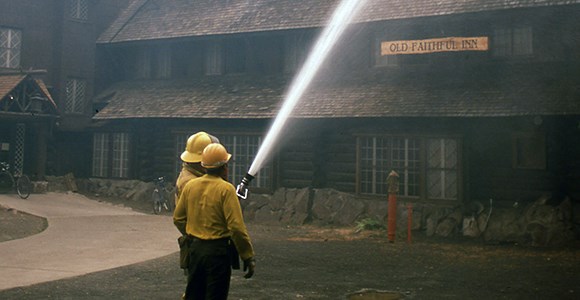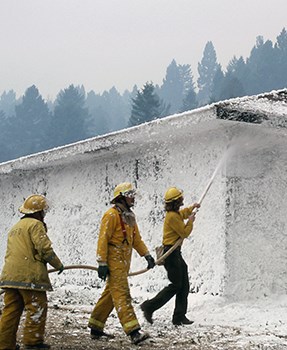Last updated: January 6, 2017
Article
Wildland Fire History — Fire Is Fire—Or Is It?

NPS photo by Jeff Henry.
Originally published April 1989 in Courier: News Magazine of the National Park Service, reprinted to commemorate the 25th anniversary of the 1988 Yellowstone Fires.
By David Butts
One area of special fire management concern is the “urban/wildfire interface” — the places where wildfires encroach on man-made structures. The National Park Service has management responsibility for many wildland areas and numerous structures located within or adjacent to them. The purposes, materials and contents of these structures vary. Even concession-operated buildings range from modern steel and concrete designs all the way to very old, all-wood buildings on the National Historic Register (Old Faithful Inn, for example). Visitor centers and museums contain 25.6 million artifacts, many of which are irreplaceable. The remainder of the approximately 16,000 structures in parks include residences, warehouses, garages, and administrative and historic buildings. NPS cities-in-the-wild also
To better understand fire-control problems associated with wildlands and structures, it's perhaps best to begin by looking at how the two differ. Fire fuels, behavior, and suppression tactics change, depending on which kind of fire is being fought. Let's look at wildfire first.
The word “wildland” might conjure up grasslands, brushfields or forests of pines and oaks. But fuel type isn't the only wildfire determinant. Vegetation varies widely in form, age, condition and moisture levels. Thousands of species of plants, each with its own size, shape, flammability and response to fire, comprise wildlands.
External factors also influence the behavior of fires burning across wildlands. The shape of the land also affects direction and rate of spread; in the absence of wind, for example, fires will run uphill. Prevailing temperature and relative humidity influence fire in opposite ways, with higher temperatures and lower relative humidity favoring burns.
Wildfires also follow a pattern of occurrence. Though they seem to pick the worst locations and the hottest days, in reality they follow a sequence of regional fire seasons, dictated by climatic and vegetative factors. Different tactics have evolved to meet these conditions. They generally aim at cutting off the spread of the fire, working from the origin around to its head, and burning out between the fireline and the fire. Taking advantage of changes in vegetation to locate the fireline in the easiest and most effective location is one option. Most of these lines are built with handtools such as shovels and pulaskis in the west and flappers and rakes in the southeast.
In almost every respect, fire behavior and suppression techniques vary markedly for structural firefighting. Although the availability of fuel, heat, and oxygen (the standard fire triangle) govern structural fires also, the rate of fire growth and spread in building is greatly influenced by the configuration of fuels into roofs, walls, floors, and doors. Structural fires have no season; they generally burn from the inside out and in any weather. The character and condition of the building and contents likewise differ.
Structural fires usually begin within a building, so the environment of the room or building determines fire spread. Typically they start slowly, then flare up rapidly. They flash over and catch walls, ceiling and contents. Windows or roofs are soon involved, and, with a fresh supply of inflowing oxygen, the free-burning fire rapidly intensifies. All this can take place in a matter of minutes.

NPS photo by Jim Peaco.
The design and construction of communities and developed park areas include fire provisions that, at older and smaller park stations, may be marginal at best. Since rescue of occupants is the primary concern, response time is of major importance, and is affected by the distance between fire stations. Unlike wildfire responses, which are measured in hours, structural fire response times must be measured in minutes.
Because of this urgency, warning and rapid suppression systems are a major concern. Modern electronic fire or smoke detectors announce beginning fires, and some transmit alarms directly to a firehouse. In some buildings, sprinkler systems both suppress fires at an early stage and trigger alarms. When arriving on-scene, engine crews locate and attack the fire and protect adjacent buildings or vehicles from fire exposure. Heat, smoke and toxic fumes require firefighters to use heavy, waterproof insulated coats, gloves, helmets, boots with steel in the soles, and a tank-type breathing apparatus.
These descriptions characterize pure wildland and pure urban fire conditions and tactics. Fires that occur on the interface between these two types are harder to define. There is no single solution to the complex problems such a fire often presents.
Some generalizations can be made about these fires, however. As a rule, an “interface fire”: involves a mixture of buildings and wildland fuels; is beyond the reach of water mains and hydrants; may be hard to reach, since access may be along narrow drives from the main roads; are in areas where structures are few, which means a low tax base for private lands; involve wildland fuels that terminate at a building's foundation, thus creating an attractive but hazardous situation; receive fire protection limited to a volunteer brigade with large response areas and an extended response time; usually involve multiple jurisdictions; and affect buildings constructed of highly flammable materials.
Because of hazards created by these factors, only a concerted effort by all fire protection authorities affords proper protection to structures. The Incident Command System (ICS) developed by the National Wildfire Coordinating Group (NWGG) is a field approach aimed at the problem. Fire training on ICS aids the effective merger of several fire departments when fires do develop.
Once a problem almost exclusive to Southern California, the volatile mixture of structures in forests and other wild areas now exists nationwide. Because wildland fuels form the matrix that surrounds structures, wildland fire danger causes critical structural fire incidents to develop. A national conference entitled “Wildfire Strikes Home” focused attention on the causes and possible solutions to these problems in late 1986. Strong support from the National Fire Protection Association and the NWCG has helped to spread word on the problem, but the main focus has been on local solutions by departments in the field.
That brings us back to the parks and their neighbors. A fire specialist soon will be added to the NPS payroll in order to address the “interface problem” in parks, to determine its scope and nature, and then define a course of action for the Service. While it's true that “fire is fire,” wildfire and structural fire
David Butts [was] chief, Fire Management, at Boise, Idaho. By the time this article appear[ed] he [had] joined the Ranger Activities staff in Washington.
